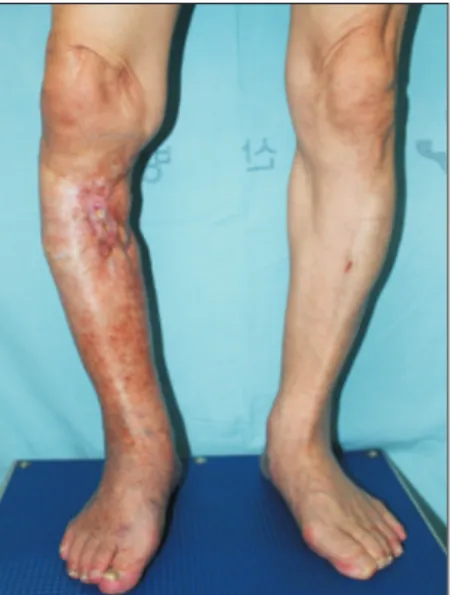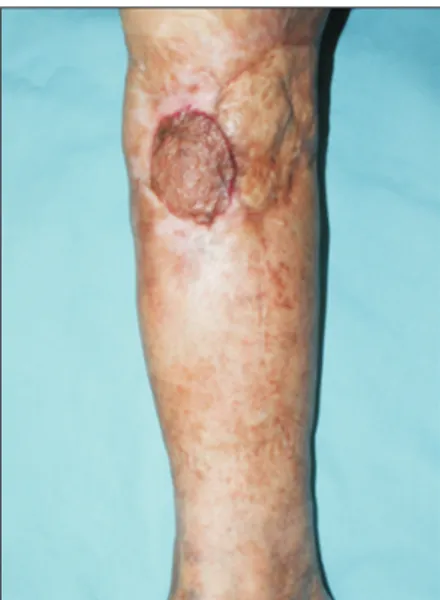www.e-arms.org 69 Reconstruction of the lower extremity is difficult due to the
lack of skin laxity and muscular tissues. With technical advances, reconstruction of lower extremity with a free flap has been accepted as a treatment of choice since the 1980s. However, if the source vessels for free tissue transfer are destroyed, free flap is not applicable. Our patient received several operations in the past for open tibial fracture and soft tissue defect. Thus, not only muscular structures but also source vessels for the free flap reconstruction were destructed. Here, we present a case of lower extremity reconstruction using anterior tibial artery perforator based segment muscle island flap.
CASE REPORT
Our patient was a 75-year-old male with a chronic ulcerative wound on the right lower extremity. He had open fracture of the right tibia due to a car accident 50 years ago and received split thickness skin graft several times to cover the soft tissue defect. Due to the accident, medial side muscles of the right lower leg were destroyed. He visited our department complaining about persistent and unhealed ulcerative lesion. Upon physical examination, a 5.0×0.5-cm-sized ulcerative wound having yellowish debris with tibial bone exposure was noted. The grafted skin was partially lost and generally contracted (Fig. 1).
The operation was planned in two steps. In the first operation, bacterial culture and thorough debridement
Perforator Based Tibialis Anterior Segmental Muscle Island Flap in
Lower Extremity Reconstruction
Il Hwan Byun, Soon Sung Kwon1, Seum Chung1, Woo Yeol Baek*
Department of Plastic and Reconstructive Surgery, Yonsei University College of Medicine, Seoul,
1Department of Plastic and Reconstructive Surgery, National Health Insurance Service Ilsan Hospital, Goyang, Korea
CC This is an open-access article distributed under the terms of the Creative Commons Attribution Non-Commercial License (http://creativecommons.org/licenses/by-nc/4.0) which permits
unrestricted noncommercial use, distribution, and reproduction in any medium, provided the original work is properly cited. Copyright © 2016 by the Korean Society for Microsurgery. All Rights Reserved.
Received July 7, 2016 Revised July 18, 2016 Accepted July 28, 2016
*Correspondence to: Woo Yeol Baek Department of Plastic and Reconstructive Surgery, Yonsei University College of Medicine, 50-1 Yonsei-ro, Seodaemun-gu, Seoul 03722, Korea
Tel: +82-2-2019-6367 Fax: +82-2-577-4914 E-mail: parande@yuhs.ac
ORCID: http://orcid.org/0000-0002-6638-4110 Financial support: None.
Conflict of interest: None.
Reconstruction of the lower extremities is difficult due to a lack of skin laxity and muscular tissues. Here, we present a case of lower extremity reconstruction via the anterior tibial artery perforator based segmental muscle island flap. Our patient was a 75-year-old male with a chronic ulcerative wound on the right lower leg from an 75-year-old car accident. A 5.0×0.5 cm size ulcerative wound with tibial bone exposure was noted. We planned to reconstruct the lower extremity defect with a free flap, but the vessel status was severely compromised intraoperatively. Thus, we found the anterior tibial artery perforator using Doppler ultrasound, elevated the tibialis anterior muscle segment flap, and transposed it to cover the defect successfully. The flap presented with a nice contour and the skin graft covering the flap survived completely. There were no complications of the surgical site at three months follow-up and no gait morbidity. This is a meaningful case applying the concept of segmental muscle flap based on a perforator that had advantages including proper bulkiness, vascularization, and preservation of function, which were well applied, leading to great success.
Key Words: Perforator flap, Island flap, Lower extremity
ARMS
Archieves of Reconstructive MicrosurgeryCase Report
pISSN 2383-5257 eISSN 2288-6184 Arch Reconstr Microsurg 2016;25(2):69-71 https://doi.org/10.15596/ARMS.2016.25.2.69
Arch Reconstr Microsurg Vol. 25. No. 2. November 2016
70
of devitalized tissue were performed. The frozen study reported that there was no malignant lesion, and only chronic inflammation was observed. After debridement, daily aseptic irrigation and dressing were performed for one month. After confirming no bacterial growth, we planned to reconstruct the lower extremity defect with a free flap. His preoperative computed tomography angiography and conventional angiography showed no fasciocutaneous perforator available for a local flap. But intraoperatively, the vessel status was more compromised than we expected, and thus we changed the plan. We found the anterior tibial artery using Doppler ultrasound and incised the lateral border of the lower extremity to confirm the anterior tibial artery perforator. Then we elevated the tibialis anterior segmental muscle flap, not involving the whole muscle to minimize the gait morbidity and then transposed it to cover the defect successfully (Fig. 2). The surface of muscle flap was covered with split thickness skin graft (Fig. 3). The flap presented with a nice contour, and the skin graft completely survived. There was no complication of the surgical site at three-month follow-up and no gait morbidity (Fig. 4).
DISCUSSION
Reconstruction of the lower extremity is challenging to plastic surgeons, especially in the middle and distal third of the lower leg. Both lack of skin laxity and adjacent soft tissues
are impeding factors. Bone and tendon are easily exposed not only in severe traumas but also in chronic wounds, and wound healing is often slow. Exposed bone and tendon require coverage with a vascularized flap and not just by a skin graft. Free flap is often performed in such cases, but in this case, there was no proper recipient vessel for a free flap.
Hallock1 recommended perforator flaps for reconstruction of lower extremity. Since Koshima first described the concept of the perforator flap, perforator flaps have been used for the reconstruction of defects and resulted in better function and cosmetic appearance. In contrast to muscle flaps, perforator flaps are easily applicable, and both contour and bulkiness are maintained because no muscle atrophy occurs.1 Furthermore, perforator flaps can be used several times if other perforators exist. In this case, the patient had severe high energy trauma 50 years ago and also received skin graft in the past. Unfortunately, because anatomical structures of the vessels and soft tissues were destroyed and the grafted skin was contracted, it was not possible to find a cutaneous perforator for a fasciocutaneous perforator flap.
The traditional protocol for middle lower extremity reconstruction recommends the local muscle flap.2
Since local muscle flap was reported by Stark,3 Mathes and Nahai4 described the soleus muscle flap for the soft tissue reconstruction of the middle lower extremity. Parrett and Pribaz5 suggested the trend of lower extremity reconstruction with local flaps. Soleus and
Fig. 2. Elevation of the tibialis anterior muscle segment flap.
Fig. 1. Preoperative view. The chronic wound of right lower extremity
Il Hwan Byun, et al. Perforator Based Tibialis Anterior Segmental Muscle Island Flap in Lower Extremity Reconstruction
www.e-arms.org 71
gastrocnemius muscle are commonly used in reconstruction of middle lower extremity. In this case, the wound was located on the medial side of middle lower extremity and medial side muscular structure was not applicable due to previous trauma. Thus we traced the anterior tibial artery and found one of the perforators that supply the tibialis anterior muscle. The segment of the muscle was elevated and transposed as an island flap to cover soft tissue defect without sacrificing the whole muscle.
This is a meaningful case applying the concept of segmental muscle flap based on a perforator. First, we used a muscle flap to cover the defect with proper bulkiness and healthy vascularized tissue. Second, we used a perforator based muscle flap, which has reliable circulation and is easy to survive and monitor. Finally, we used only segment of the muscle to preserve its function. The patient had no complaints of gait morbidity or ankle movement. Applying these advantages, our patient was treated with great success and no complications. We conclude
that a perforator based segmental muscle island flap is an excellent option in the lower extremity reconstruction with difficult situations.
REFERENCES
1. Hallock GG. A paradigm shift in flap selection protocols for zones of the lower extremity using perforator flaps. J Reconstr Microsurg 2013;29:233-40.
2. Grotting JC, Vasconez LO. Regional blood supply and the selection of flaps for reconstruction. Clin Plast Surg 1986;13:581-93.
3. Stark WJ. The use of pedicled muscle flaps in the surgical treatment of chronic osteomyelitis resulting from compound fractures. J Bone Joint Surg Am 1946;28:343-50.
4. Mathes SJ, Nahai F. Clinical applications of muscle and musculocutaneous flaps. St. Louis: Mosby; 1982.
5. Parrett BM, Pribaz JJ. Lower extremity reconstruction. Rev Med Clin Condes 2010;21:66-75.
Fig. 4. Postoperative 3-month view.

